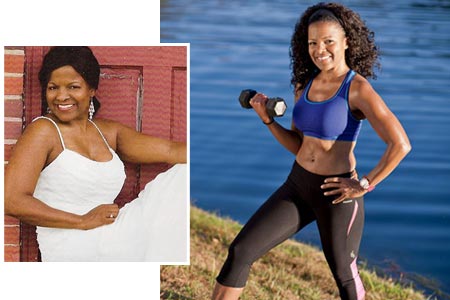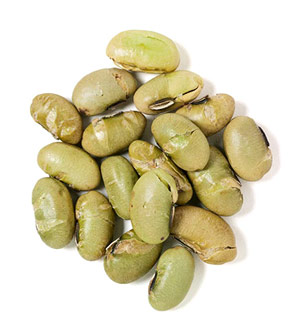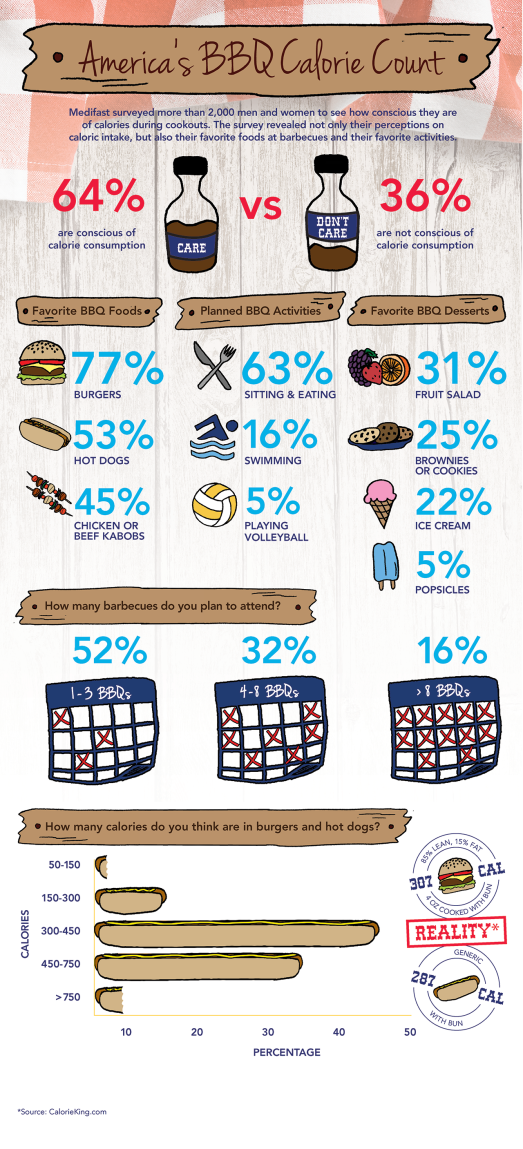Before: 185 lbs (83.9 kg)
After: 120 lbs (54.4 kg)
Although she stands only five feet tall, 27-year-old Krystal Sanders was never petite. Growing up, she subsisted on fast food and “anything you could microwave.” A size 14 when she moved to Austin, Texas, in 2005 to work as a revenue services specialist, she continued to hit the drive-through five nights a week. When she began planning her wedding in early 2008, the added stress drove her to eat even more. “I was in denial and avoided scales, cameras, and mirrors,” she says. But she couldn’t avoid the size-18 tag on her wedding gown.
The Change
When Krystal’s wedding photos arrived in October 2008, she didn’t want anyone to see them. “I looked at the pictures alone and I cried,” she says. “It was a reality punch in the face. I was embarrassed that I’d let myself get that large.” She knew something had to be done.
The Lifestyle
Krystal emptied her pantry and fridge, tossing all chips, frozen pizza, and other junk. Instead of eating out, she started cooking healthier versions of her favorite restaurant foods, boosted her veggie intake, and measured portions. “It was an eye-opener to see the difference between what I would normally eat and what the serving size was,” she says. When she worked up the courage to step onto a scale, it read 185 pounds. She began jogging on her treadmill for 30 minutes six times a week. Over the next year, she added DVD strength workouts, cut out soda and processed foods…and reached her goal of 130 pounds. But she wasn’t finished. She began lifting heavier weights, and in December 2009, the scale flashed 120. “I couldn’t believe it. I thought maybe the scale was broken,” says Krystal.
The Reward
Now Krystal has the energy to log nine-mile runs and go biking and hiking with her husband. And she is anything but camera shy. “I used to run from cameras, but now I like what I see in photos,” she says. “I’m finally at peace with the way I look.”
Krystal’s Tips
Add iron. “Don’t be all cardio all the time—lift weights! Replacing fat with muscle means you can burn more calories without even trying.”
Greek out. “I use low-fat Greek yogurt in place of mayo in recipes, and it tastes great. It can also be used as a sour cream substitute.”
Be prepared. “Set everything out the night before: clothes, weights, water bottle. Then nothing can get in the way of your workout.”
YOU LOSE YOU WIN. Tracey Dickson, 44
One flight attendant discovers how to lose weight during a chaotic time in her life.

BEFORE 158 lbs
AFTER 117 lbs
Although her job as a flight attendant forced her to eat out at least four nights a week, Tracey Z. Dickson, 44, of San Antonio, Texas, stayed trim by teaching cardio and boot camp classes and running about 20 miles a week. But in April 2008, Tracey discovered a cancerous lump in her breast. “My life hit a wall,” she says. Chemo sapped her strength, while steroid pills left her ravenous, so Tracey ate—and ate. “I decided that because I was going through a sucky situation, I would eat whatever I wanted,” she admits. In four months, the scale flashed up to 158. “I had never weighed that much,” says Tracey, who stands 5’3″. “I knew that couldn’t be healthy on my petite frame.”
THE CHANGE
In September 2008, Tracey’s mom tried to motivate her to get off the couch. “She told me that my body was used to being active, so the best medicine was to stop lying around,” says Tracey. “The person in the mirror looking back at me was not me, so I got moving.”
THE LIFESTYLE
After a double mastectomy, Tracey was declared cancer-free in October 2008. One month later, she stepped onto a treadmill at the gym, where she built up to running for 30 to 60 minutes five days a week; she also strength trained twice a week. By March 2009, Tracey was down 20 pounds. Encouraged, she began training for 10-Ks and tossed all junk food. When she hit 128 pounds in June 2009, she decided to “become stronger and leaner after cancer than I was before it.” After plateauing at 122 two months later, she added reps to her strength routine and was happy to reach 117 pounds in October. “I couldn’t believe it!” she says. “I hadn’t seen that number since high school!”
THE REWARD
Tracey is more active than ever, running about six 10-Ks and half marathons each year—double her pre-cancer mileage. “I am stronger than I ever imagined,” she says. “I have all-day energy and believe I can do whatever I set my mind to.”

TRACEY’S TIPS
Trick your sweet tooth.
“Instead of dessert, I’ll have a baked sweet potato sprinkled with cinnamon. It tastes like I’m eating sweet-potato pie, but for a ton less calories.”
Speak up.
“When you eat out, ask what the dishes are cooked in. It’s your body; you should be able to decide what you put into it.”
Make a workout date.
“You can’t blow it off without feeling like you’re letting down a friend, so you’re more likely to stick to it.”
Shannon Moore

“I feel amazing inside and out!”
Playing softball helped keep Lincoln, Nebraska, native Shannon Moore, 31, a slim size 6 throughout high school, but her weight started to creep up after she landed an office job. Tethered to her desk, she never exercised–and she started ordering pizza or a giant burrito for lunch. “I ate whatever was most convenient,” she says. “I never thought about nutrition.” In 2006, Shannon wore a size 14 dress to her wedding, then tacked 25 more pounds of “love chub” onto her 5’8″ frame during her first year of marriage.
Before 179 lbs
After 138 lbs
The Change
In January 2008, Shannon’s company instituted a system that used health tests to determine employees’ insurance deductibles. Shannon, who was 179 pounds at that point, was looking at a steep increase in payments. “Finally,” she says, “I had a reason to get fit.”
The Lifestyle
For a week, Shannon wrote down everything she ate. “Turned out that if it wasn’t takeout or fast food, my meals came from a box,” she says. “And I was drinking five cans of soda a day!” She began trading processed foods for fresh fruits and veggies, learned to cook healthy versions of the greasy dishes she used to order in, and joined a gym to walk on the treadmill or use an elliptical for 30 minutes five days a week.
Six months later, she was 10 pounds lighter. To accelerate her weight loss, she stopped chasing workouts with a big bowl of cereal, upped her cardio sessions to one hour, and added strength training three times a week. By December 2010, she dropped 31 more pounds and was a size 4. “I had a fit body again, and I loved it!” she says.
The Reward
Shannon is now at a healthy weight and up for any fitness challenge. “It’s very liberating when you’re not restricted by your body,” she says. “My confidence is high, and I feel that I can accomplish anything I set my mind to.”
Shannon’s Tips
Keep your thighs on the prize.
“I set new goals and give myself nonfood rewards when I reach them, such as a bottle of nail polish or a good book.”
Have night sweats.
“I’m a night owl, and sometimes I head to the gym at 9 p.m. and stay as late as midnight. I don’t feel as rushed when it’s less crowded, and I have more time to focus on my workout.”
Go au naturel.
“Running is my time to decompress, so I try to find scenic routes where all I can hear is the birds chirping. There’s nothing more relaxing, and it makes my run go by faster.”








































 \
\












While stress is one of the most-often cited reasons why people can’t sleep, there’s another factor that could be keeping you up at night: your diet. Certain foods can significantly interfere with your sleep, including the five worst of the worst below.
What Are the Five Worst Foods for Sleep?
Recent Study Gives Clues on How Diet Impacts Sleep
Sleep Tip: Stop Eating at Least Three Hours Before You Go to Bed
Diet Is Only One Factor in Getting a Good Night’s Sleep